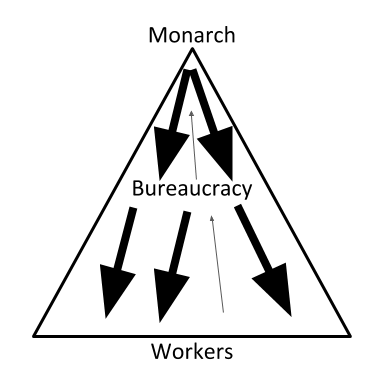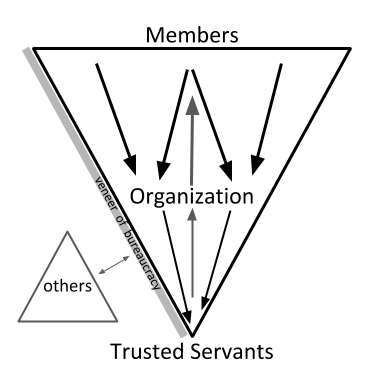The Twelve Step Trapezoid
Overview
While a typical business relies on a monarch-based pyramid, Twelve Step programs strive to implement a member-driven upside down pyramid. In practice, no one has yet implemented a perfect upside down pyramid. Instead, Twelve Step programs use a trapezoid.
The Historic Pyramid
Historically, organizations have a powerful leader with weak followers. Thinking, power, and decision making are controlled by the monarch. Communication comes from the monarch and flows downward to the workers. Little communication flows back to the leader. This structure does what it is supposed to do when the monarch is highly competent. At best, this structure is as competent as the leader.
The Upside Down Pyramid
Fellowships strive to place the members first. Decisions are supposed to derive from the will of the members. Trusted servants are in place simply to ensure that the will of the members is fulfilled. The majority of the communication flows from the members to the organizational structure with a bit flowing further along to the most trusted servant. Little communication needs to flow from the trusted servants to the members other than “yes, we did as you asked.”
Since no human organization is perfect, the middle layer sometimes becomes more bureaucratic. Since unbounded desires lead to chaos, checks are put in place on what the members can request. Also, no organization lives in a vacuum. Even the most perfect fellowship must still communicate with other organizations - such as the tax authority.
The end result is that while all fellowships talk about the upside down pyramid, some act more like a bureaucracy, and some follow a hybrid model based on a trapezoid.
The Twelve Step Trapezoid
The actual organizational structure for most Twelve Step fellowships is a hybrid. It is partially an upside pyramid serving the fellowship and partially a traditional bureaucracy serving itself and the outside world. The bureaucracy cannot be shed because lawyers, tax agents, governments, and other expect to see a classic pyramid with a monarch.
Note that I am not implying that a typical Twelve Step fellowship only has a single “mini-monarch.” This organizational structure is recursively built upon the thinking of every trusted servant. The structure of this type of organization compels every trusted servant to be part monarch and part servant.
This is a challenge. Members enter our fellowship with expectations based on the classically pyramidal outside world. When they accept a service position they go through a cultural adjustment. They slowly learn that leaders are actually servants. They learn that the chair of a committee is the least important person on the committee. It takes time to learn and practice the humility required to be a servant leader.
Then, about the time the servant leader conceptual model begins to make sense, the fledgling servant typically encounters the fellowship’s bureaucracy. We think we have found the organization structure deemed best by our higher power only to discover that this structure has feet of clay. The further you progress in your role as a trusted servant, the more you are reminded that we still live in an imperfect world.
The goal is to live more in the organizational part of the trapezoid and spend less time in the bureaucratic part. Structurally, we need to keep the top of the trapezoid as broad as possible, while simultaneously striving to minimize the breadth of the middle. The middle is where bureaucracy resides. We need that bureaucracy because the outside world expects it. We also need that bureaucracy because we are imperfect and have not yet figured out how to competently implement the upside down pyramid.
A Goal
A goal to strive for is an upside pyramid with as little bureaucracy as possible. We need a bureaucratic interface to deal with the outside world and to compensate for our human imperfections. Ideally, we want our bureaucracy to be a thin veneer, primarily on the exterior, and nearly invisible from the inside.
It might take a thousand years to reach the level of perfection shown in the diagram that follows. However, we can start now. If every decision is made as a trusted servant rather than as a monarch, we strengthen our organization and starve the bureaucracy.
In the meantime, however, I am grateful that there is a place for me in our Twelve Step trapezoid.
The Upside-Down Pyramid - an illustration by one member
The Preface to the Twelve Concepts from Nar-Anon Family Groups reads:
“Just as freedom for the individual comes from the Twelve Steps and freedom for the group springs from the Twelve Traditions, so freedom for the service structure flourishes from the Twelve Concepts.”
Quoting, with modification, from the Narcotics Anonymous Guide to Local Services regarding Area Committee Policy and Guidelines:
“Area committees exist primarily to help make NA groups more effective in carrying the recovery message to the still-suffering... Area committee services either:
attract (members) to meetings,
provide materials for use in meetings,
conduct activities designed to strengthen meetings, or
perform the administrative functions necessary to do these things.”
Quoting from the Nar-Anon Concepts: “12. In keeping with the spiritual nature of Nar-Anon, our structure should always be one of service, never of governance.” Alcoholics Anonymous illustrates this form of organizational structure in their booklet The Twelve Concepts for World Service with an inverted pyramid. One member’s adaptation of that illustration is shown, below.






